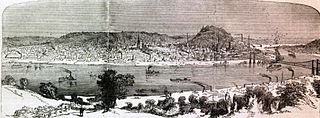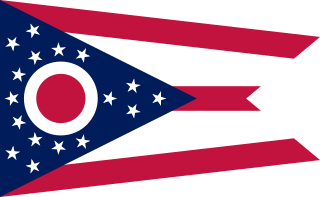 W
WDuring the American Civil War, the Ohio River port city of Cincinnati, Ohio, played a key role as a major source of supplies and troops for the Union Army. It also served as the headquarters for much of the war for the Department of the Ohio, which was charged with the defense of the region, as well as directing the army's offensives into Kentucky and Tennessee.
 W
WThe 5th Ohio Infantry Regiment was an infantry regiment from southwestern Ohio that served in the Union Army during the American Civil War, serving in both the Eastern and Western Theaters in a series of campaigns and battles.
 W
WThe 6th Ohio Infantry Regiment was a regiment in the Union Army during the American Civil War, primarily serving in the Western Theater in a series of campaigns and battles.
 W
WThe 75th Ohio Infantry Regiment, sometimes 75th Ohio Volunteer Infantry was an infantry regiment from southwestern Ohio in the Union Army during the American Civil War. It served in the Eastern Theater, most notably in the battles of Chancellorsville and Gettysburg and then in the siege operations against Charleston, South Carolina.
 W
WThe 104th Ohio Infantry Regiment, sometimes 104th Ohio Volunteer Infantry was an infantry regiment in the Union army during the American Civil War. It played a conspicuous role at the Battle of Franklin during the 1864 Franklin-Nashville Campaign, where six members later received the Medal of Honor, most for capturing enemy flags.
 W
WNicholas Longworth Anderson was a United States Army officer who served in the American Civil War as Colonel of the 6th Ohio Volunteer Infantry. After the Civil War, he was nominated and confirmed for appointment to the brevet grades of brigadier general and major general of volunteers.
 W
WPowhatan Beaty was an African American soldier and actor. During the American Civil War, he served in the Union Army's 5th United States Colored Infantry Regiment throughout the Richmond–Petersburg Campaign. He received America's highest military decoration, the Medal of Honor, for taking command of his company at the Battle of Chaffin's Farm, after all officers had been killed or wounded.
 W
WThe Black Brigade of Cincinnati was a military unit of African-American soldiers, that was organized in 1862 during the American Civil War, when the city of Cincinnati, Ohio, was in danger of being attacked, by the Confederate Army. The members of the Cincinnati "Black Brigade" were among the first African Americans to be employed in the military defense of the Union. The fortifications—including forts, miles of military roads, miles of rifle pits, magazines, and hundreds of acres of cleared forests—at the border of Northern Kentucky thwarted the major threat to Cincinnati during the Civil War.
 W
WHenry Martyn Cist was an American soldier, lawyer, and author who was a Union Army captain and staff officer during the American Civil War. On December 11, 1866 he was nominated and on February 6, 1867 he was confirmed for appointment to the grade of brevet brigadier general of volunteers, to rank from March 13, 1865. He is most noted for his classic and oft-referenced 1882 book The Army of the Cumberland. In addition, Cist led pioneering efforts to preserve and interpret the sites of the battles of Chickamauga and Chattanooga.
 W
WJohn Cook was a bugler in the Union Army during the American Civil War. At age fifteen, he earned the United States military's highest decoration, the Medal of Honor, for his actions at the Battle of Antietam.
 W
WThe Defense of Cincinnati occurred during what is now referred to as the Confederate Heartland Offensive or Kentucky Campaign of the American Civil War, from September 1 through September 13, 1862, when Cincinnati, Ohio was threatened by Confederate forces.
 W
WCamp Dennison was a military recruiting, training, and medical post for the United States Army during the American Civil War. It was located near Cincinnati, Ohio, not far from the Ohio River. The camp was named for Cincinnati native William Dennison, Ohio's governor at the start of the war.
 W
WGood Samaritan Hospital, the oldest and largest private teaching and specialty health care facility in Cincinnati, Ohio, United States, was opened in 1852 under the sponsorship of the Sisters of Charity. The hospital is member of TriHealth, a joint operating agreement between Catholic Health Initiatives and Bethesda, Inc. Cincinnati to manage Good Samaritan.
 W
WWilliam Haines Lytle was a politician in Ohio, renowned poet, and military officer in the United States Army during both the Mexican–American War and American Civil War, where he was killed in action as a brigadier general.
 W
WThomas Kilby Smith was a lawyer, soldier, and diplomat from the state of Ohio who served as a general in the Union Army during the American Civil War and then in the postbellum United States Army. He led a brigade and then a division in the Army of the Tennessee in several of the most significant campaigns of the Western Theater of operations before failing health forced him to a series of desk jobs.